-
Get the Most Out of Your RV Battery
Les Schwab is here to help you get the most out of your RV batteries, whether you need to recharge, replace, or you have questions about the best battery setup for your needs. Getting a charge out of your RV and trailer adventures begins and ends with the right battery.
Keeping Your Batteries Charged
During the winter months and long stretches where the battery will not be used, be sure to take your batteries out of your RV or trailer and hook them up to a trickle charger. These small units plug directly into a 110-volt outlet and allow you to keep your batteries fresh and fully charged until you’re ready for your next outdoor adventure.
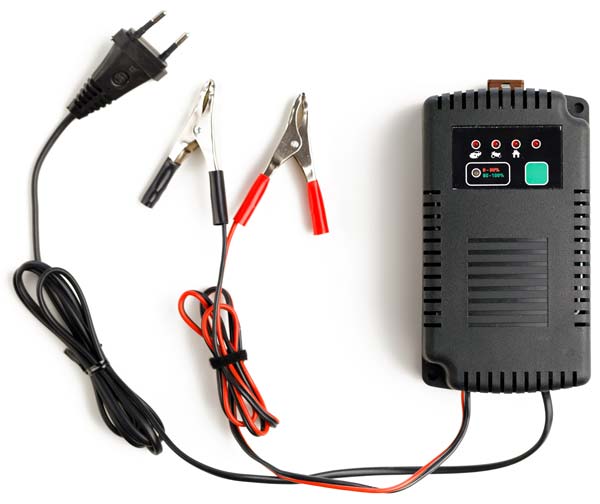
Les Schwab Tip: It’s a good idea to get your RV and trailer batteries fully charged every year. If your 12-volt battery reaches just 11.2 volts, it’s considered completely discharged. Your local Les Schwab does free battery charging and visual inspections.
12-volt vs. 6-volt
Almost every RV and trailer will come equipped with one or even two 12-volt batteries running in parallel. There’s nothing wrong with this setup. The battery boxes and enclosures are built for those size of batteries. But with a few changes, and a switch to a series of 6-volt batteries, you might get more reserve capacity, which means you can draw power for a longer amount of time between charges.
The benefits of a standard 12-volt battery include the uniformity (your RV or trailer will most often come with 12-volt batteries), cost (12-volt batteries can be less expensive), and simple installation. However, 12-volt batteries may not recharge as quickly as a 6-volt. When it comes to power and longevity, it can take up to three 12-volt batteries running in parallel to match the amp hours in a series of two 6-volt batteries.
Other benefits of running 6-volt batteries in series include a larger amp hour capacity (the amount of time you can use the battery), and a longer battery lifespan. The only real downside is that there may be size differences. 6-volt batteries can sometimes be taller. This can require changes to your battery box or battery storage area.
Les Schwab is Your Battery Expert
Stop by your local Les Schwab before you head out on your first RV or trailer outing of the season. Our team of professionals is here to ensure your batteries are properly charged and installed correctly with our best-in-the-business warranty.
-
How Your Auto Battery Works
Here’s a simple guide to understanding how car batteries work, from the alternator to cold cranking amps to different types of car batteries. Find out:
- How a battery starts your car
- How the battery provides power
- What cold cranking amps are
- How the battery recharges
- Why car batteries die
- What the different types of auto batteries are
How a Car Battery Starts a Car
The first purpose of an auto battery is to provide power for starting your vehicle. It also acts as a surge protector for the car’s computer and provides power for short-term use of things like lights, stereo, GPS or wipers when the engine is off.
The car battery is part of the starting system. There are three main components in this system:
- The ignition switch is either the starter button you press or where you insert your key.
- The switch controls the starter relay (also called a solenoid). When you turn the ignition, it sends a small electrical current to the starter relay. This causes a pair of contacts to close.
- When those contacts close, the battery sends voltage to the starter motor, which turns some gears to start the car.
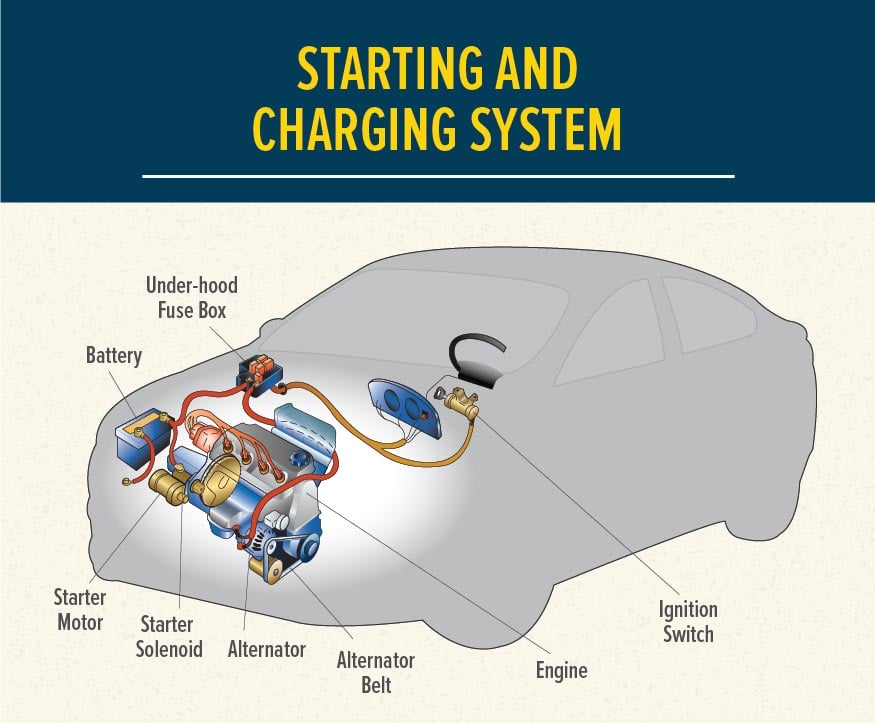
How the Battery Provides Power
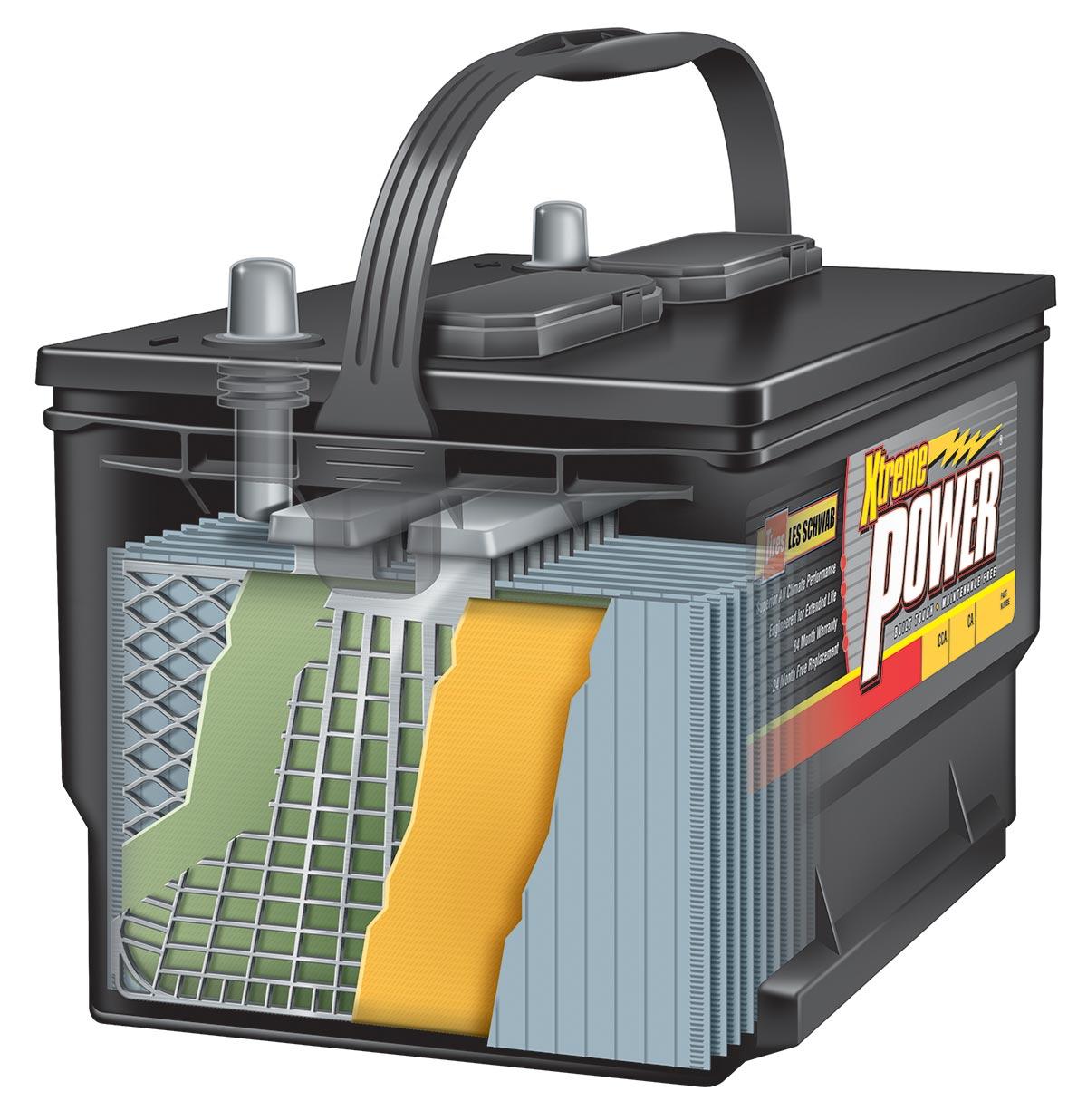
The two types of auto batteries — flooded and AGM batteries — use lead-acid technology. A typical lead-acid car battery contains plates of lead alternating with plates made up of other materials, all immersed in an electrolyte solution of about one-third sulfuric acid and two-thirds water.
Turning the ignition triggers the acid in the liquid electrolyte solution to react with the active material on the plates (active material refers to any substance in the battery that reacts with the solution to discharge or recharge the battery). This generates a bigger electrical current. The current travels through the starting system in a chain of reactions that cues the engine to start.
What Are Cold Cranking Amps?
Cold cranking amps (CCA) refers to the amount of power a battery can supply for 30 seconds even at low temperatures. Larger engines require more power to start, as does starting the car for the first time on a cold day.
A high CCA rating is important for standard auto batteries in areas with subzero temperatures, since deeply discharged wet cell batteries can freeze solid in such weather.
How the Car Battery Recharges
The alternator is responsible for recharging your car battery as you drive. This part also supplies power for your car’s electronics when you're underway. It is driven by the alternator belt from the engine. As the belt goes around, it generates electrical current to run your vehicle's electronics. It also sends some current back to the battery to recharge it.
A voltage regulator controls this flow of electricity to keep it even and deliver the right amount of charge to meet needs like running the AC or heater. It also protects the battery from overcharging, which can damage it.
Why Does My Battery Die?
Over the life of a battery, discharge-recharge reactions happen thousands of times. Each cycle wears out the plates a bit, and over time the lead deteriorates. As your car battery loses capacity, cold cranking amps decrease.
Deep discharging, which happens when you use the battery to run the stereo, lights or other electrical systems in your car when the engine is off, is responsible for a good portion of battery failures. Discharging most of your battery's capacity by using it in this manner for too long and then recharging it through driving can cause the sulfur in the electrolyte solution to stick to the lead and create other damage to the plates in the battery.
What Are the Different Types of Auto Battery?
The two most common auto batteries for sale today are standard wet cell batteries and absorbed glass mat (AGM) batteries. Both use lead-acid technology. The differences are in the needs of the car.
Standard Wet Cell Batteries
These are also called flooded, conventional or SLI (starting, lights, ignition) batteries. Some standard batteries have vents that allow for airing out corrosive gases, steam, and condensation (these may be called vented batteries). They have removable caps for adding fluid. Other wet cell batteries are closed systems, with no removable caps.
- Service needs: Occasional simple maintenance including cleaning off corrosion on terminals and topping off the fluid with distilled water if the battery has removable caps. The battery should be visually checked every year. Battery charge should be checked before road trips and after summer before temperatures fall.
Absorbed Glass Mat (AGM) Batteries
These are a type of VRLA battery, which stands for valve-regulated lead-acid. They’re sometimes called regulated valve, dry cell, non-spillable or sealed batteries. They are called sealed because they have no removable caps, don’t vent gases and can’t leak any acid. They do have pressure-activated relief valves that open only if the battery overheats during recharging.
Some newer cars, such as those with start-stop technology, require AGM batteries. These batteries will continue to deliver power to a car’s computer and electronics even when the engine isn’t running.
AGM batteries hold a charge longer than standard wet cell batteries. They can tolerate periods of disuse and repeated deep discharging and recharging cycles better than flooded batteries. They have a short recharge period but they can be easily damaged by overcharging. They also perform well in harsh climates with extreme heat or cold.
- Service needs: Charge should be checked before road trips and after summer before temperatures fall.
Wet cell batteries and AGM batteries are not interchangeable — your car requires one or the other.
Learn More -
The Real Reasons Your Car Battery Keeps Dying
Modern car batteries are designed to start your car or truck, run all of the electronics, and maintain the vehicle’s computer memory. But over time, batteries do eventually run out of juice — sometimes way before their time. Here are the real reasons your car battery dies, or keeps dying, and what you can do to get the most out of it.
Les Schwab Tip: If your battery seems to die while you’re driving, it could be an issue with your vehicle’s electrical components or charging system. You might need to visit your mechanic or stop by Les Schwab so we can double-check your battery and connections.
Why Your Car Battery Keeps Dying
While car batteries slowly die over time, high heat, brutal cold, excessive use of vehicle accessories (after-market equipment), and other mechanical issues can shorten the life of even the toughest battery. Read How Your Battery Works to understand why batteries die over time. The top six reasons batteries die include:
Lights left on. That can be your car headlights, dome light, light in the glove box, or trunk light. Even vanity mirror lights can drain a battery if left on overnight.
Parasitic draw. Your car battery can drain over time from stereo components (subwoofers), phone chargers, and anything you leave plugged into vehicle outlets that continue to draw power from the battery after the car is turned off. Other power drains include interior and below-vehicle LED lights.
Loose or corroded connections. A loose connection can damage the battery and/or drain it. Check your battery cables often for corrosion. If you find any, clean it off to ensure a tight connection.
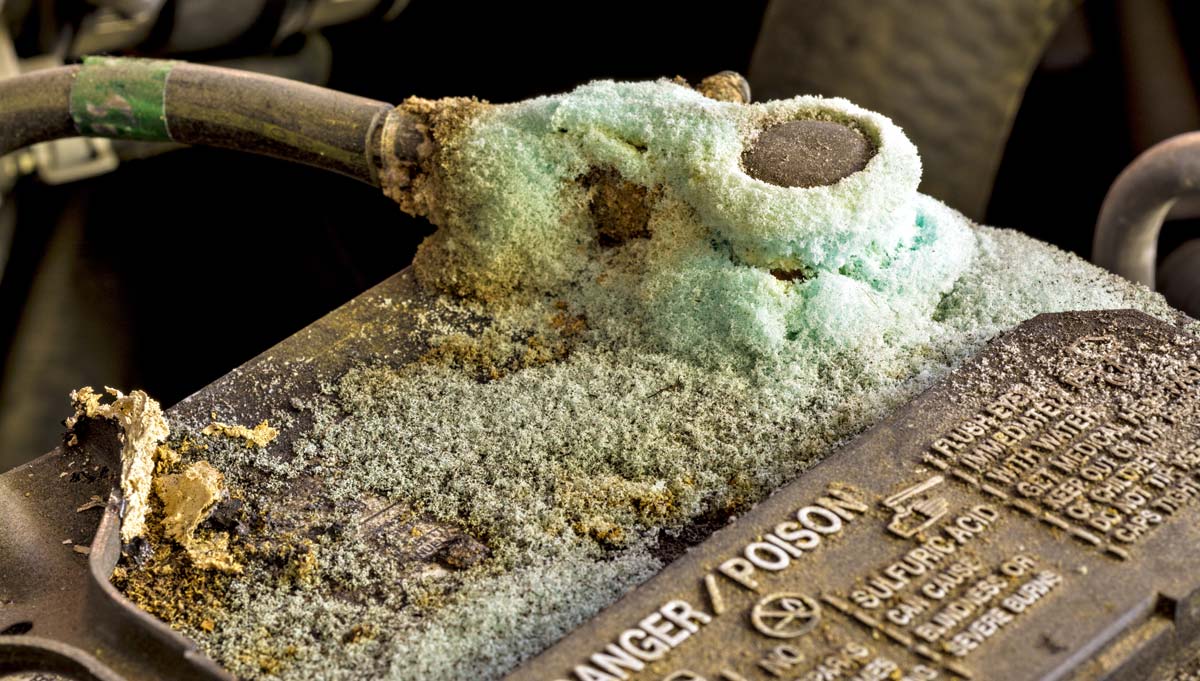
Excessive heat and cold. It seems like batteries die most often in the winter. You go to start your car, and the battery just cannot turn the engine over. But it’s not the cold that kills most batteries. Hot summer months can deteriorate your battery. Then, you notice that lack of power in the winter. To help avoid damage to your battery from heat, park your vehicle in a garage or under a shelter on hot summer days.
The alternator has issues. Once your car is started, the alternator helps it stay charged. But if the alternator is going bad or the alternator belt is slipping, it might not recharge your battery.
Quick trips or leaving your car parked too long. Too many quick trips (less than 15 minutes in length) can degrade a battery. Additionally, letting a car sit for too long without being started (weeks or months) can cause issues.
Age. Batteries don’t last forever. How often you start your vehicle, how far you drive, the health of your alternator, the hot and cold conditions in your region, and more can affect the lifespan of your battery.
How to Prevent Your Battery From Draining, and What Causes It
The life of your car battery depends on where you live, how much you drive, and more. If your car needs a new battery, Les Schwab is here to help with batteries for everything you drive. Here are a few tips to help keep your battery from draining.
Unplug Extra Accessories: Known as parasitic draw, your car battery can drain from stereo components and phone chargers that continue to work when the car is turned off. Also, be on the lookout for glove-box lights, trunk lights, and interior lights that remain illuminated.
Take a 15-minute drive: At least once per week, take your car for a short drive. As long as your alternator is working correctly, this will help maintain the battery state of charge.
Don’t leave your headlights on: Turn the switch to the “off” position, even if your lights go off automatically.
Avoid deep discharging: Don’t leave the lights on or the stereo going while the car is turned off. This can result in a dead battery.
Tighten and Clean Battery Connections: If your battery terminals are loose or corroded, they can drain or damage the battery. It could also cause your car to stall. If you do find corrosion, it’s easy to clean with a stiff-bristle brush (an old toothbrush works great), and a mixture of one part baking soda to three parts water. With a little elbow grease, the corrosion will vanish. Just be careful not to get any of the baking soda/water mixture in your battery or on other parts of your engine or vehicle.
What to Do When Your Battery Dies
Dead batteries happen to everyone. It can be frustrating, especially when you’re late for work. Having a set of jumper cables or a jump starter can get you going again. We’ve put together a jump-start how-to video to help get your car or truck started.
When you’re a Les Schwab customer, you’re welcome to call us during regular business hours. If we’re available, we may be able to drive to your location and give you a jump start.
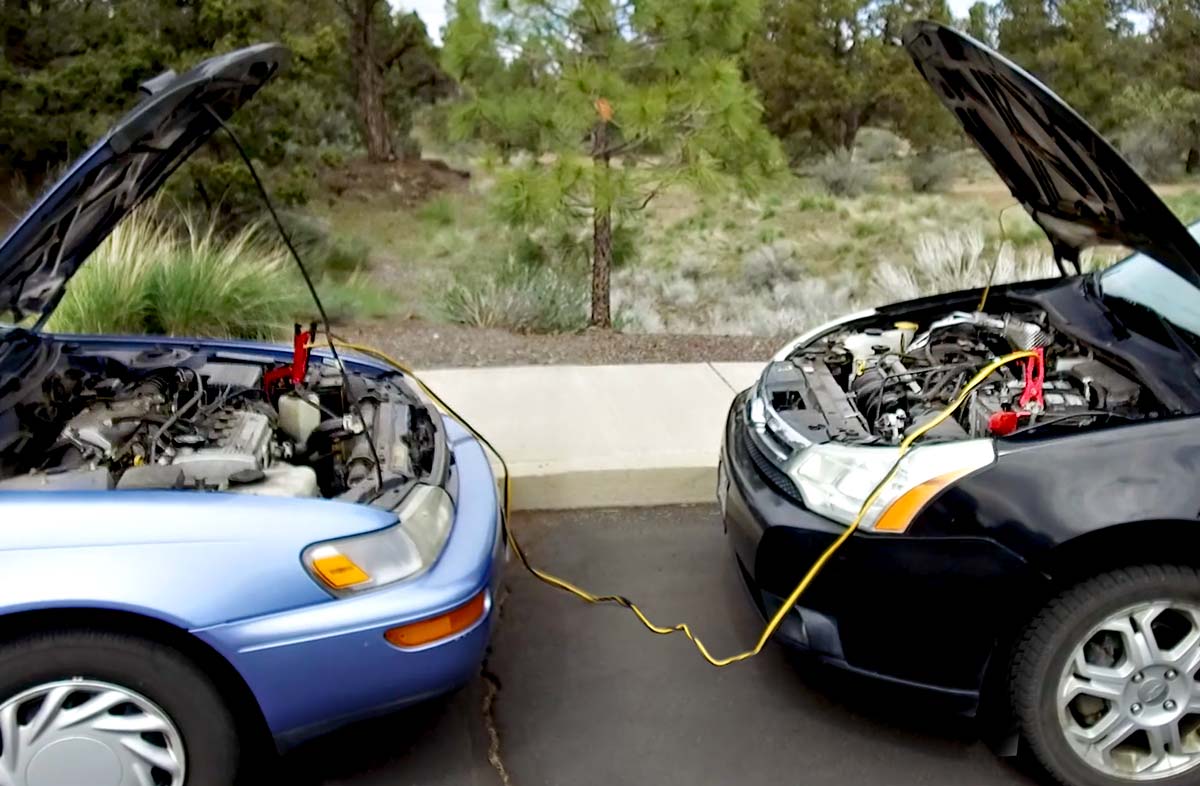
Need More Help? Give Us a Visit!
Les Schwab gets a charge out of checking your battery. Come on by and we’ll perform a free inspection. Whether it just needs to be recharged or if you need a new battery, we can help, including new batteries for most vehicles.
-
Seasonal Car Battery Care: Why and How
An average car battery will last 4 to 5 years, maybe even up to 7. But where and how you drive and what the weather’s like in your area affect its life. Many short trips are harder on batteries than fewer, longer ones. In hot climates, you may only get 2 to 3 years out of a new battery.
Unless you’re having obvious trouble, you may just ignore it. But it’s a good idea to get your auto battery checked every fall. As cold weather arrives, the everyday work of starting up and powering your vehicle gets harder, and summer heat may have taken an invisible toll. Those battery problems you run into in the winter likely started in the summer.
What Does Summer Heat Do to a Car Battery?
Hot weather is the harshest environment for car batteries.
When it’s 90 or 95 degrees outside, it’s 140 to 150 degrees under your hood. These high temperatures can cause the water in your vehicle’s battery to evaporate. High heat can also force some of the fluid out of the battery vents in the form of gases. That will cause a chemical reaction with the lead and other metals on the battery connector. If you see corrosion that looks like white or blue crystals on the nodes with + and – signs (your battery terminals), that’s why.
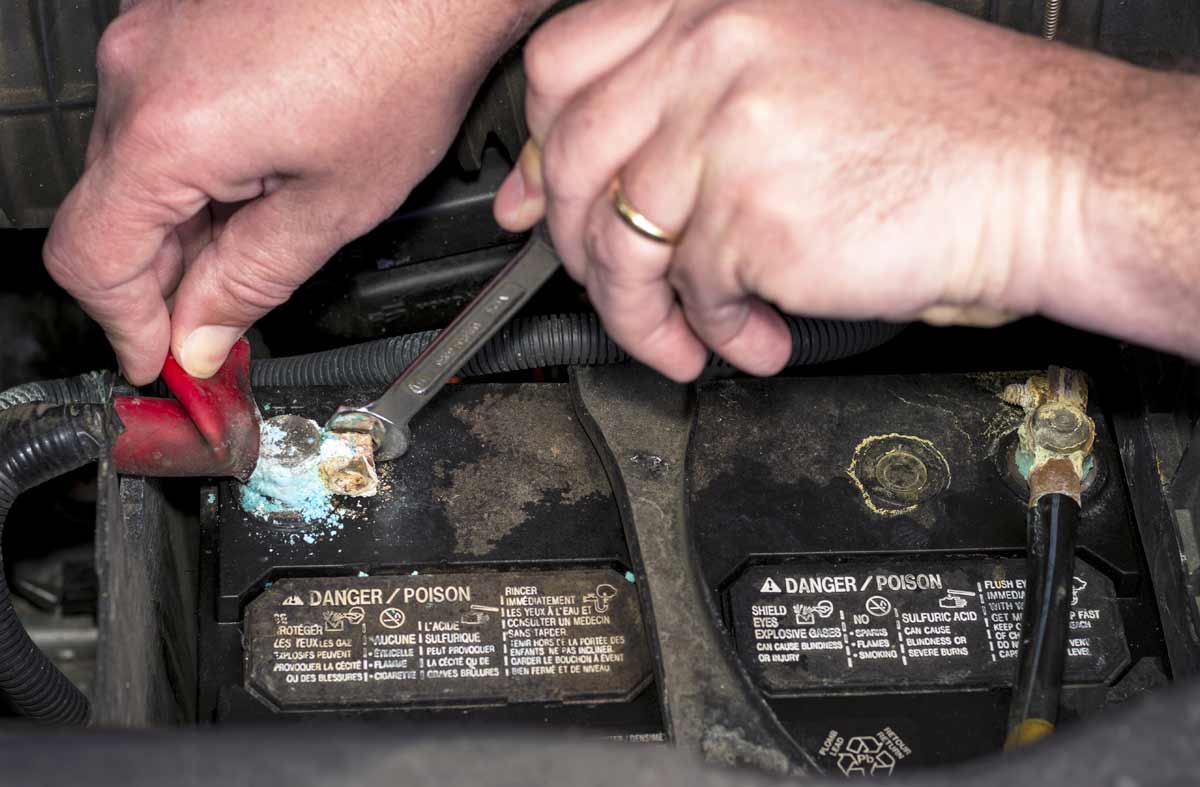
The inside of a typical lead-acid car battery is like a layer cake made up of plates of lead and other components, with the “frosting” being a solution of about one-third sulfuric acid and two-thirds water. When some of that water evaporates or some sulfuric acid is forced out because it’s hot, there's not enough fluid to surround the plates. At that point, they start corroding.
About half of premature battery failures are caused by the loss of fluid in the battery. You may not see this damage, but it will reduce your battery’s efficiency.
Then there are the ways you use your vehicle in the summer. A battery can be pushed to its limit with demands from the engine cooling fan, air conditioning, stereo, and GPS or other gadgets you charge on your road trip. Deep discharges also speed up the battery’s aging. This can happen whenever you use the car’s electrical system while it’s turned off.
How to Take Care of Your Battery in Summer
Avoid deep discharges. It’s fun to park by a lake and listen to music through your car’s stereo and handy to charge your phone from the 12V socket while you’re camping, but draining the battery significantly can damage its internal parts.
Use the car regularly during heat waves. It’s not just cold weather that can damage a battery left unused — heat is harmful to sitting batteries, too. Park in the shade whenever possible. Keeping the temperature under the hood even a bit lower than it would otherwise be will slow fluid evaporation.
Speaking of battery fluid, faster evaporation in the warm months will increase corrosion. Clean any corrosion off the top of your battery once a year and make sure the cables are tightly connected. Corrosion is caustic, so make sure you wear gloves and proper eye protection to do this. Dissolve some baking soda in a bit of water and use a toothbrush to gently scrub the battery terminals and cable clamps.
Why Won’t the Car Start When It’s Cold Outside?
If it’s worked hard over summer, or the weather was really hot, your car’s battery may not be as efficient come fall, for the reasons above. If it’s not operating right it will have trouble holding a charge and delivering cranking power to the engine.
A telltale sign that your battery needs attention is if you notice your car is slow to turn over on chilly mornings but easier in the afternoon. This happens because all the fluids in your vehicle are thicker when temperatures are lower, like syrup that's straight out of the fridge versus warm. So it takes more power to move the motor oil required to crank the engine. Also, the chemical reactions that happen in the battery are slower in the cold.
With newer cars, you might not even have a slow start — your car simply won’t start.
Simply put, your vehicle’s systems need additional output from the battery to operate in colder conditions. If your battery is old, needs recharging, or isn't able to hold a charge, it will struggle to perform in the cold weather.
How to Take Care of Your Battery in Winter
First, get your battery tested in the fall, between summer heat and winter cold. A test will tell you if the battery is fully charged, how many cold cranking amps it can provide, and generally how healthy it is.
Keep a battery charger on hand and use it if you’re driving your vehicle less often in the cold months, you make frequent very short drives, or if you’re having trouble starting in the morning. If you live in a very cold climate where temps can get down to 5 degrees F, consider using a block heater or battery blanket.
A block heater will warm your engine so it's easier to start the car. A battery blanket will, as the name suggests, keep your battery warmer so the fluid keeps moving and it’s easier for the battery to crank the necessary amps when it’s cold out. Depending on where you live, you may want to use both these items — talk to a mechanic to figure out what you need.
Keep jumper cables in your car, as you’re more likely to need them in the winter.
Heading into the cold months, take a few minutes to clean corrosion off the top of your battery and make sure the cables are tightly connected.
We’ve said it twice, but it’s important enough to say one more time: Autumn is the time to get your battery checked to avoid irritating problems in the winter. If your vehicle’s battery is over 4 years old, it’s especially important to get it checked annually.
-
Need a New Battery? Start Here.
If you’re wondering how often you should change your car battery, how long it takes to change a battery, or why your battery died suddenly without warning, the answer might not be what you’re expecting.
Leaving Battery Installation to the Professionals
At one time, removing your vehicle’s old, dead battery and installing a new one was an easy bit of car maintenance. Today’s vehicles are more complex. And, so are today’s automotive batteries. Vehicles from the mid-90s may require special equipment and care when changing a new battery. In fact, don’t be surprised if you’re not sure how to even unhook your car battery.
The reason for that complexity? Most of today’s cars and trucks are packed with computers and other special electronic equipment that rely on a continuous power supply. Incorrectly changing out a battery can affect your radio presets, security system, power windows, as well as your air conditioning and heating controls.
More importantly, a loss of power during battery installation can also cause unseen issues to your vehicle’s operating systems. Because today’s automotive computers adapt while you drive, a loss of power can negatively affect systems that regulate your transmission, engine efficiency, and battery charging.
Batteries aren’t always under the hood of today’s vehicles. They may be located on the inside of your vehicle, which require a specific battery that needs ventilation to keep harmful gasses out of your vehicle’s interior.
Start at Les Schwab
If you think you have a drained battery, head over to a Les Schwab near you. Our battery installation teams use the latest equipment to maintain power to those sensitive systems during the battery installation process. We also use the latest in diagnostics and testing equipment to check the overall health of your battery, charging and starting systems.
Know the Nearly Dead Battery Warning Signs
It doesn’t take a lot of power to start today’s vehicles, which means you might not get the telltale slow-start associated with a dying battery. You might not even notice your battery is going dead until it’s too late.
Things that can contribute to a drained battery include extreme hot and cold weather, how often and far you drive each day, how long your vehicle is parked in one location without being started, and if you have any aftermarket equipment installed such as a stereo or auxiliary electronics and lighting. See our article How Your Auto Battery Works to understand why batteries die over time and how a car battery recharges.
LesSchwab Tip: Because the signs of a weak battery might not be as noticeable and batteries rarely die at a convenient time, the professionals at your local Les Schwab can check your battery condition for free — even if it isn’t dead.
While it’s common to experience a dead battery in the winter, it’s actually the hot, summer months that cause most battery wear and tear. This is due to an increase in the chemical reactions inside the battery during hot days. When the weather gets cold, that damage is more likely to cause battery failure.
Enjoy up to a Seven Year Battery Warranty
Get a jump on your next battery at your local Les Schwab. We carry automotive batteries for cars, pickup trucks, SUVs, crossovers, RVs, and more. We’ll help you find the best battery for your vehicle and get you quickly back on the road. Our professional installation takes the guesswork and worry out of buying a new battery. Learn more at Les Schwab Tire Centers.
-
How to Jump-Start a Car
Starting your car is a rather easy process, unless the battery has completely failed. Then, you’re not going anywhere. Luckily, jump-starting your vehicle is also easy. All you need are the right tools and know-how to get it done right. Here’s what you need to know.
Common Reasons for a Battery Dying
We’ve all left the lights on in a car or truck only to find a dead battery a few hours later. Thankfully, that doesn’t necessarily mean the battery has failed or reached the end of its life. It may be possible to jump-start it and enjoy years of uninterrupted use. To get the most out of your battery, try to avoid a few battery-killing scenarios.
Deep Discharging: leaving the lights on or the stereo going while the car is turned off. This can result in a dead battery or a clicking noise when you try to start the vehicle.
Hot Summer Days: Hot, summer months can deteriorate your battery over time. You simply notice it in the winter when it takes more power to crank over a cold engine — power the deteriorating battery doesn’t have. If you can, store your vehicle in a garage or under a shelter on the hottest days.
Corroded Connections or Cables: Check your battery cables often for corrosion. If you find any, clean it off to ensure a tight connection.
Les Schwab Tip: The professionals at your local Les Schwab can check your battery for free – even if it isn’t dead. We may be able to recharge it at no cost if it’s still in good condition.
Must-haves for Jumping a Car Battery
Jumper Cables or a Jump Starter: Jumper cables come in various lengths. The ends of the cables include red and black alligator clips made of copper. To jump-start a car, these clamps attach to the leads of the dead battery and to the vehicle that will help jump-start the dead car or truck. See below for proper procedures. Jump starters come with a smartphone-sized 12-volt battery and a set of red and black cables and clips. These attach to the battery of the dead vehicle and quickly jump-start it with a burst of power.
Gloves: A simple pair of rubber gloves can help protect your hands from corrosive battery acid and other harsh chemicals. Keep a pair with your jumper cables or jump starter.
A Vehicle With a Working Battery (If Using Jumper Cables): To successfully jump-start a vehicle, you’ll need another car or truck with a working battery.
Jumpstarting Your Car: What Are the Steps?
When you have the right tools and know-how from the pros at Les Schwab, jumpstarting your car is easy.
Line up the front of your vehicles and open both hoods.
Take the key out of the ignition in the car with the dead battery. The other vehicle should not be running.
Untangle your jumper cables.
On the dead battery, hook up the red or positive clamp to the positive post on the battery.
Hook the red clamp on the other end of the jumper cables to the positive post on the good battery.
Important: Be sure the black clamps do not touch the red clamps.
Attach the negative or black cable to the good battery. Then connect the other end of the black cable to the negative post on the dead battery. You can also attach it to a piece of solid metal in the engine compartment.
Important: Keep your jumper cables away from engine fans or hot engine components.
Start the vehicle with the working battery and let it run for a few minutes.
Now, try starting the vehicle with the dead battery. If it starts, let it run for a few minutes. If not, allow the car to charge for another minute before another attempt.
To remove the cables, start with the black cable on the previously dead car, then remove the black clamp off the starter car. Finally remove the red from the newly jumped vehicle, and then from the other car or truck.
Les Schwab Tip: Once a car is successfully jumped, you’ll want to go for a short, 30-minute drive. This will give the alternator a chance to recharge your battery, if the alternator and/or battery are in proper working order. If it does not hold a charge, bring it in to Les Schwab for a quick check.
How to Prevent Your Battery From Draining?
The life of your car battery depends on where you live, how much you drive, and how often you start your vehicle. But you can also help prevent it from draining with a few tips.
Unplug Extra Accessories: Known as parasitic draw, your car battery can drain over time from stereo components (such as subwoofers), and phone chargers that continue to work when the car is turned off. Also, be on the lookout for glove-box lights, trunk lights, and interior lights that remain illuminated when the vehicle is off.
Take a 15 Minute Drive: At least once per week, take your car for a short drive. As long as your alternator is working correctly, this will continually recharge your battery.
Don’t Leave Your Headlights On: Turn the switch to the “off” position, even if your lights go off automatically.
Tighten and Clean Battery Connections: If your battery terminals are loose or corroded, it can cause your car to stall. It could also damage the battery.
Les Schwab Gets a Charge Out of Checking Your Battery
With today’s modern vehicles, it can be difficult to tell if your car battery is going dead until it’s too late. Come by your local Les Schwab Tires for a free inspection of your car battery. We carry new batteries for most vehicles, and offer recommendations to keep you from getting stranded.
Shop for Batteries -
Batteries for Anything You Drive
Les Schwab is well known for having the West’s largest selection of tires. Here are four reasons to come to us for batteries as well.
1. Vast Selection
We have an inventory of quality batteries to power just about anything that rolls:
- Cars, light trucks and SUVs
- Commercial vehicles and heavy-duty trucks
- Motorcycles
- Motorhomes/RVs, fifth-wheels and other campers
- Boats, including personal watercraft
- Off-road vehicles (four-wheelers/quads and side-by-sides)
- Farm tractors and equipment
- Golf carts
- Lawnmowers
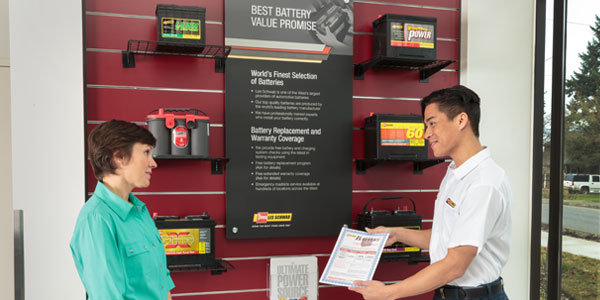
2. More for Your Money
What we say about tires also goes for our batteries: If we can’t guarantee it, we won’t sell it. Our best-in-the-business battery warranty includes a replacement program. We’ll replace standard batteries that are deficient absolutely free for a period between 12 to 24 months, depending on the battery. For motorcycles, golf carts and the like we provide replacements for failed batteries up to six months after purchase. The period for RV, commercial and marine battery replacements extends for one year.
And if your battery fails any time before its expected life after that, we'll refund you the difference. For some batteries, that can mean coverage extending up to seven years.
You’ll also get free auto battery and charging system inspections with your purchase. And you can stop by for a free battery charge at any Les Schwab whenever you want.
3. Expert, Friendly, World-class Service
Our technicians are equipped with state-of-the-art battery diagnostic tools and are well trained in batteries and charging systems. A problem you suspect is being caused by your battery may actually be something wrong elsewhere in the charging system. (Read more.)
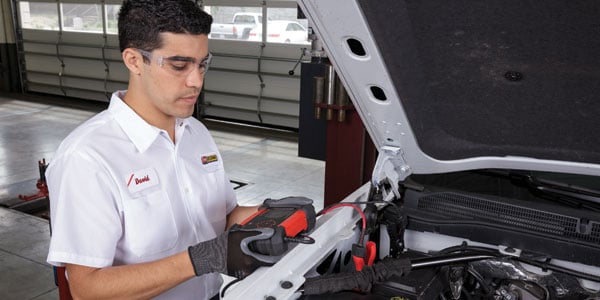
We check any vehicle battery charge for free, whether you bought it from us or not. We’ll give you an honest answer on whether you need a new battery. If you do, one of our service techs will help you decide what battery is best for the job, the vehicle and your budget. Then we’ll install it quickly so you can get on your way without delay.
4. Hundreds of Locations
You can buy, get service on or redeem a warranty for Les Schwab batteries at any of our 480-plus locations across the West. Not sure if you need a new auto battery? We’ll check your battery’s charge while you wait — for free.
For a quality battery backed by a great warranty, come to a Les Schwab Tires near you.
Shop for Batteries -
Starting Problems? How to Tell If It’s the Battery or Alternator
Nothing is worse than getting into your gas- or diesel-powered car or truck, hitting the ignition and going nowhere. Sometimes the issue can be the battery. On the other hand, a failing car alternator will cause your vehicle to shut off soon after you get it started because it’s not recharging the battery. Here are the signs and symptoms of a bad battery or car alternator and how to determine which one is causing issues.
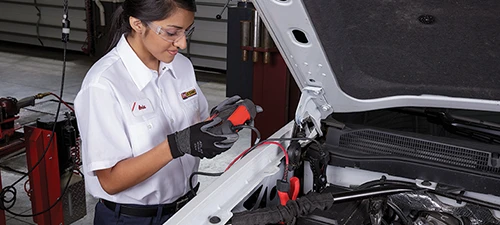
Signs & Symptoms of a Bad Battery
There are some telltale signs of a bad battery. Look for these issues when your car is hard to start, starts inconsistently, or there’s no sound or light on when you hit the ignition.
- Dashboard and interior lights are dim
- Windshield wipers are slow or barely move at all
- Electric windows slowly open or close
- Battery and/or cables are corroded
- Radio won’t turn on
- Swollen battery
You could have a bad battery if the cranking of the engine is sluggish, there’s no sound or interior lights when you try to start the vehicle, your car starts inconsistently, or you can start it with jumper cables but the vehicle will not start again after being shut off. A loose or corroded connection can also cause issues. Not sure? Get to Les Schwab and our pros will take a look and share some options.
How to Tell if Your Battery Is the Problem
If jump-starting works, then it’s probably your battery. The question then is, how old is that battery? If it has been starting your car or truck for more than four years, it could just be at the end of its lifespan. But a battery can also be drained when the lights are left on when the car isn’t running. The pros at Les Schwab have the tools needed to tell the difference and make recommendations.
Schedule A Free Battery Check Schedule A Free Battery Check 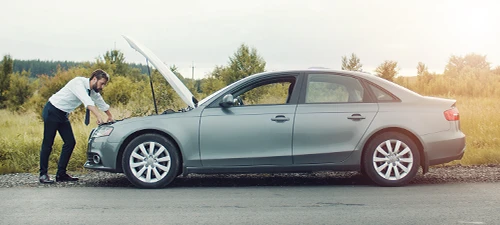
Signs & Symptoms of a Bad Alternator
Gas and diesel-powered vehicles use an alternator to keep the battery charged and run all of the electric systems, such as your radio, windshield wipers and comfort controls. Essentially, the alternator is a small generator that creates electricity from a belt directly connected to the engine. As long as that alternator is creating electricity and the battery is good, your car should start and stay running. If the vehicle won’t crank or start but the headlights are still working, look to problems with the starter or other parts of the engine.
How to Tell if Your Alternator is the Problem
While it can be difficult to tell if your alternator is creating electricity without a lot of specialized tools, there are some signs to watch for:
- Trouble starting the vehicle
- Frequent stalling after you’ve started your vehicle
- Squealing sound coming from the engine that gets louder when you use the heater or sound system (this may be your alternator bearings)
- Interior and exterior headlights that seem to dim and brighten
- Check-engine or battery indicator light illuminated on your dashboard
- Vehicle immediately stops running after a jump start
Here’s a quick way to diagnose your alternator: Get the vehicle started (if possible). Then turn on your radio and tune to a low number on the AM dial. Finally, rev the engine. If you hear a whine or the sound goes fuzzy when you hit the gas, your alternator is probably failing.
Schedule A Free Battery Check Schedule A Free Battery Check Can You Drive with a Bad Alternator or Battery?
It is possible to drive with a bad alternator or battery. But you probably won’t get far. With a bad battery, you’ll be stuck the next time you go to start your car. A bad alternator will quickly deplete your car battery and could cause your vehicle to stall at any time. Even while you’re driving.
To avoid being stuck on the side of the road or someplace you don’t want to be, get a free battery and alternator inspection at Les Schwab. If it’s the battery, we’ll help you choose the right one for your vehicle. If it’s the alternator, we’ll make recommendations and help plan your next steps.
What’s the Purpose of Your Car Battery & Alternator
An auto battery supplies an initial electric charge that travels through the starting system on both gas and electric vehicles. Once a gas- or diesel-powered vehicle is running, an alternator sends current back to recharge the battery as you drive. It supplies power for your car’s electronics when you’re underway and makes sure the right amount of charge goes back to the battery.
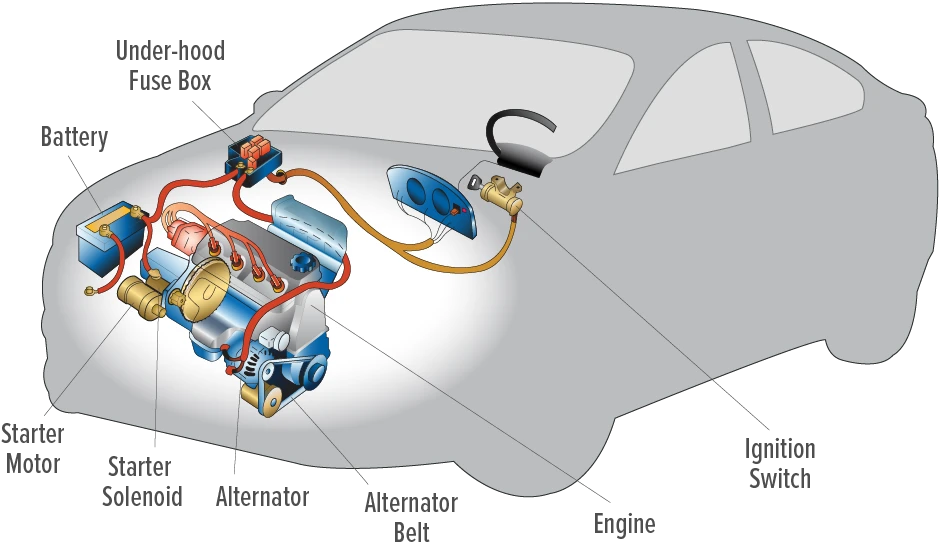
If Your Car Still Won’t Start, Stop by Les Schwab
Diagnosing battery and alternator issues isn’t always easy. If you’re experiencing any of these issues, get your vehicle to Les Schwab for a free inspection and some solid advice. Our trained technicians have the tools and experience to pinpoint the issue fast. That includes inspecting your battery fluid level, the posts (the terminals marked + and -) for corrosion, and cables for snug connections, as well as measuring the voltage and cold cranking amps (CCA) along with your alternator’s voltage and current output.
Schedule A Free Battery Check Schedule A Free Battery Check -
What To Do When The Car Battery Light Goes On
Every day, there are thousands of things that go right with your car or truck. That includes starting up when you turn the key or hit the start button. But when the 12-volt battery light shows up on your dashboard, it can feel like a big deal, especially if your car has felt sluggish to start. Here’s what you need to know and how to pinpoint the issue.
Learn more about car batteries and how they work from the Les Schwab professionals.
Understanding The Battery Light
When the battery light appears on the dash of your gas-powered or EV vehicle, it can indicate a loose cable, bad wiring, or a dying battery. In gas-powered vehicles, it can also be an alternator issue. Or it might be nothing. If the indicator goes away after a few minutes or disappears after you restart your vehicle, there’s likely nothing to worry about.
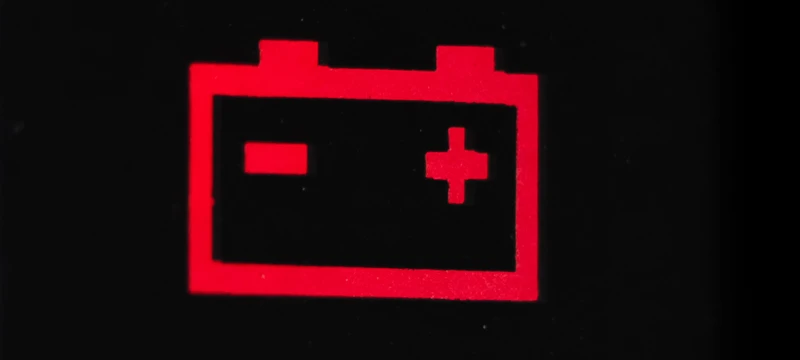
The times you do need to worry about that battery alert include:
- Weak battery: The battery is not holding a charge and has trouble starting your vehicle.
- Failing battery: Eventually, every car battery needs to be replaced. As a battery gets older, it becomes more difficult for them to hold a charge. If your battery is more than five years old, it’s time to get a new one.
- Faulty alternator: If this is not working properly, the battery cannot be recharged and will quickly die. Alternator issues can include broken or damaged belts.
- Loose or corroded battery connections: A loose connection or corrosion can damage the battery and/or drain it. Check your battery cables often. If you find any loose cables, tighten them. If you find any corrosion, clean it off to ensure a tight connection. Learn how to remove corrosion from your battery.
- Electrical system issues: These problems can include faulty voltage regulators or wiring. Unless you like working under the dash to trace wires back to their origin and fuse, this is often the job for a professional.
Steps To Take If The Battery Light Turns On
Most of the time, the cause of the battery light is something that is easily fixed. The professionals at Les Schwab are happy to give your battery a free visual inspection. If the terminals seem loose or there’s significant corrosion, they can give you several options.
Want to check things on your own? Try these quick inspections.
Look for loose connections.Check the connection where the terminals attach to the battery posts. Are they loose? If so, tighten them up.
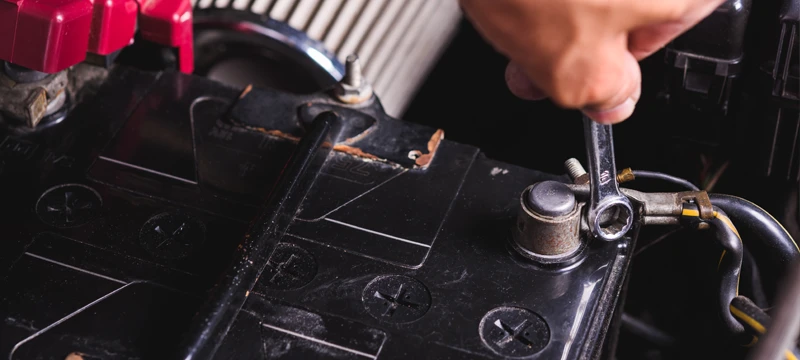
Look for corrosion. If you find corrosion, a white powdery substance that forms on battery posts and terminals, clean it off. Here is some advice on how to remove corrosion from your battery.
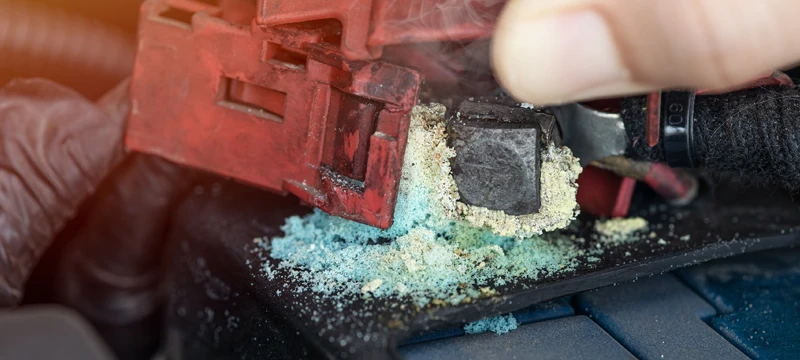
Check your battery voltage. If your 12-volt battery reads less than 11.8 volts, you have a dead battery that either needs to be replaced or recharged. Need help checking the voltage on your car’s 12-volt battery? Stop by Les Schwab for a quick battery check.
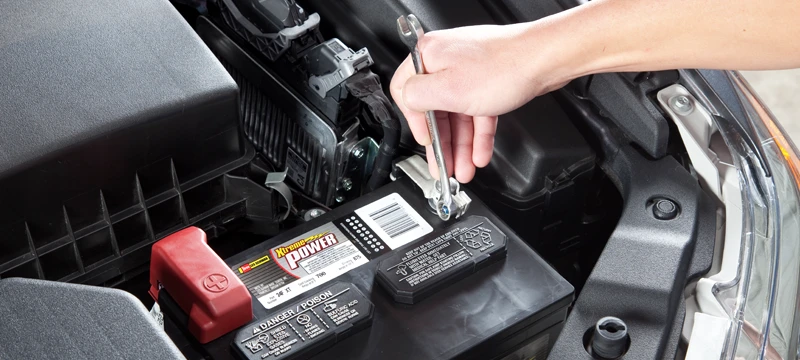
Troubleshooting The Battery Light
If the battery indicator is still on and you’ve tightened the cables, cleaned the corrosion, and checked the battery power, the next step is to stop by Les Schwab. We carry batteries for nearly everything you drive and offer free battery charging and free battery checks. If you need a new battery, we’ll remove the old one, clean up the cables, and install the new one. It’s our way of keeping you from getting stranded on the side of the road.
Preventing Future Battery Issues
Les Schwab is here to help you recognize the signs of a bad or dying battery, including the effects of cold and hot weather on that 12-volt bit of automotive wonder. To prevent future battery issues, come by for a free pre-trip safety check, which includes a visual inspection of your battery.
